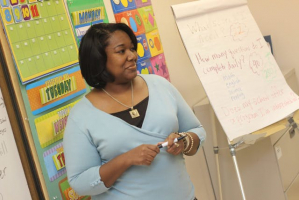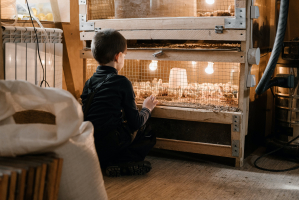Top 10 Best Expository Essay Topics and Samples
Going on a journey of expression with the best expository essay topics and samples. These carefully curated subjects offer inspiration and insight into ... read more...effective expository writing. Explore the richness of diverse topics and accompanying samples to refine your skills and engage readers with compelling narratives.
-
Essay topic: Which three qualities of a leader are the most important?
Answer:
In a world where leadership shapes the course of nations and organizations, identifying the paramount qualities of a leader is crucial. Imagine a ship without a capable captain, adrift and rudderless. Leadership is the compass that guides teams toward success. In this essay, we will delve into the three qualities that stand out as the most important for effective leadership.
Among the myriad qualities a leader should possess, the first vital trait is integrity. A leader's honesty and consistency create a foundation of trust within a team. Studies show that teams led by individuals with unwavering integrity perform better and exhibit higher morale. For instance, when a leader consistently adheres to ethical standards, team members are more likely to follow suit, fostering a culture of trust and reliability.
Another indispensable quality is empathy. A leader who understands and resonates with the emotions and needs of their team builds a cohesive and motivated workforce. Empathetic leaders actively listen to their team members, address concerns, and provide support. This emotional intelligence fosters a positive working environment, enhancing collaboration and innovation. Research indicates that teams led by empathetic leaders show increased job satisfaction and productivity.
The linchpin of effective leadership is decisiveness. Leaders must make tough choices swiftly and confidently. Decisiveness propels a team forward, preventing stagnation and indecision. When leaders can assess situations, weigh options, and make informed decisions, teams are more likely to navigate challenges successfully. Decisive leaders inspire confidence, instill a sense of direction, and propel their teams toward achievement.In conclusion, integrity, empathy, and decisiveness emerge as the trifecta of essential leadership qualities. Leaders who embody these traits create a resilient and empowered team. As we navigate the complexities of the modern world, recognizing and fostering these qualities will not only shape effective leaders but also contribute to a more prosperous and harmonious society. The question remains: Are we cultivating these qualities in our leaders, and what can we do to ensure their prevalence in the leaders of tomorrow? The journey toward exceptional leadership begins with acknowledging and prioritizing these fundamental qualities.

Photo by Rebrand Cities via pexels 
Photo by Christina Morillo via pexels -
Essay topic: Imagine your soul would reincarnate in animal form. Which animal would it be and why?
Answer:
A world where our souls, after this lifetime, take the form of animals. The thought ignites our imagination and raises intriguing questions about the essence of our being. In the symphony of existence, what creature would embody the spirit of our soul? This essay explores the whimsical concept of soul reincarnation into animal forms.
If my soul were to find a new home in the animal kingdom, it would undoubtedly choose the wise and majestic owl. Owls symbolize wisdom and intuition across cultures. Their ability to navigate the darkness with keen senses resonates with the idea of an enlightened soul guiding its way through the mysteries of life.
Owls, with their silent flight and piercing gaze, represent the introspective nature of a soul seeking deeper understanding. Evidence of this symbolism lies in ancient folklore and mythology, where owls are often associated with knowledge and spiritual insight. This choice aligns with the belief that, in the animal realm, wisdom would be a guiding force.
The supporting evidence for this choice lies in the owl's unique characteristics. Owls are known for their exceptional vision and hearing, allowing them to perceive truths hidden in the shadows. Similarly, a soul reincarnated as an owl would have the ability to see beyond the surface, grasping the profound meaning of experiences and connections.
Analyzing the symbolism further, the owl's nocturnal nature represents the soul's resilience in navigating the challenges and uncertainties of life. In choosing the owl, the soul seeks not only wisdom but also the strength to endure and thrive in the face of adversity.
The central idea here is that the soul's choice of an animal form is deeply rooted in its desire for enlightenment and connection with the spiritual realm. The owl's symbolism and unique attributes align harmoniously with these aspirations. In essence, the soul's reincarnation as an owl signifies a profound journey towards higher understanding and insight.In the tapestry of existence, the idea of the soul reincarnating as an owl underscores the universal quest for wisdom and transcendence. It invites us to ponder the nature of our own journey and the symbolic significance embedded in the choices we make.
In conclusion, the concept of our souls taking animal form adds a layer of enchantment to the eternal cycle of life. If my soul were to embark on such a whimsical journey, the wise and enigmatic owl would be its chosen vessel. This contemplation prompts us to reflect on the symbolic animals that might encapsulate the essence of our own souls. As we navigate this human experience, let us embrace the mysteries and connections that transcend the boundaries of our existence. What other enchanting possibilities await us in the dance of reincarnation?
Photo by RF._.studio via pexels 
Photo by Marcus Aurelius via pexels -
Essay topic: If you could build a house in any place of the world, where would it be?
Answer:
Imagine the possibility of crafting your dream abode in any corner of the world, where the scenery reflects your desires and the environment resonates with your soul. The idea of choosing the perfect location for a home is a tantalizing prospect that sparks the imagination and stirs the yearning for a place uniquely yours. In this essay, we explore the intriguing question: If you could build a house in any place of the world, where would it be?
The first destination that captivates my vision is the serene embrace of the Swiss Alps. Nestled amidst snow capped peaks and lush green valleys, the Alps offer a picturesque panorama that transcends the ordinary. The supporting evidence lies in the therapeutic tranquility of the mountains, providing a sanctuary for contemplation and a respite from the hustle of daily life. The crisp mountain air and the majestic scenery would create a harmonious haven for a tranquil retreat.
Turning our gaze to the second option, the allure of the Amalfi Coast in Italy beckons. Here, the azure waters of the Tyrrhenian Sea caress the rugged coastline, dotted with colorful villages and vibrant flora. The supporting evidence rests in the Mediterranean charm that characterizes this region, fostering a sense of warmth and cultural richness. The Amalfi Coast offers not only breathtaking landscapes but also a connection to the timeless beauty of Italian art, cuisine, and lifestyle.
However, the central idea guiding this choice is the desire for a harmonious blend of nature and culture. The ideal location for my dream home is Kyoto, Japan. This city is a symphony of ancient traditions and modern elegance, set against the backdrop of serene temples, cherry blossoms, and enchanting gardens. The supporting evidence lies in the cultural tapestry of Kyoto, offering a seamless integration of historical charm and contemporary sophistication.
Kyoto encapsulates the essence of a place where nature, culture, and modernity converge seamlessly. It is a testament to the belief that a home should not only be a physical structure but a reflection of one's aspirations and values.
In conclusion, the hypothetical prospect of building a house anywhere in the world invites contemplation on personal preferences, aspirations, and the intrinsic connection between a home and its surroundings. If given the chance, Kyoto, with its timeless beauty and cultural richness, would be the canvas upon which the walls of my dream home would rise. As we ponder our ideal locations, may this exercise prompt us to appreciate the diverse wonders our world has to offer and inspire us to create spaces that resonate with our deepest selves. What locations, yet unexplored, might hold the keys to our dream homes? The journey to find that perfect spot is a quest worth undertaking.
Photo by Binyamin Mellish via pexels 
Photo by Pixabay via pexels -
Essay topic: Which part of the school building would you redesign/remove and why?
Answer:
Consider the school building as a dynamic space that shapes the educational experience of students. In contemplating potential enhancements, one area stands out for reconsideration, the traditional, enclosed library. While libraries have been integral to education, reimagining this space could better align with evolving learning methods and foster a more interactive and collaborative educational environment.
The first main idea centers on transforming the conventional library into a versatile and technology integrated learning hub. Traditional libraries, with rows of silent shelves, limit the potential for collaborative and dynamic learning experiences. Supporting evidence lies in the shift towards digital resources and online databases, rendering extensive physical book collections less essential. A redesign could allocate this space to accommodate modern technology, interactive displays and collaborative workstations, promoting a more engaging learning environment.
The second main idea involves creating flexible, multipurpose spaces that cater to various educational activities. The rigid structure of traditional classrooms impedes the adaptation of teaching methods to suit diverse learning styles. Supporting evidence comes from the growing acknowledgment of the importance of experiential and project based learning. Redesigning classrooms to be modular and adaptable allows educators to create dynamic spaces tailored to specific lessons, fostering a more interactive and personalized learning experience.
The most important central idea centers on enhancing communal areas for student collaboration and social interaction. Current school designs often lack sufficient spaces where students can collaborate, share ideas, and engage in extracurricular activities. Supporting evidence comes from the recognition that holistic education extends beyond traditional classrooms. Redesigning communal areas to accommodate group activities, clubs, and informal gatherings encourages a sense of community and supports the development of vital interpersonal skills.
In conclusion, the redesign or removal of the traditional library space represents an opportunity to align educational environments with contemporary learning needs. By transforming this space into a technology-infused, collaborative hub, schools can better cater to the evolving needs of students. Additionally, creating adaptable classrooms and fostering communal areas for interaction ensures a holistic educational experience. The evolution of school spaces reflects a commitment to preparing students for a future that demands flexibility, collaboration, and innovation. As we contemplate redesigning elements of the school building, let us envision spaces that inspire curiosity, creativity, and a love for lifelong learning.
Photo by Pixabay via pexels 
Photo by Idriss Meliani via pexels -
Essay topic: Have you decided what you want to become in the future? Explain your choice.
Answer:
In the vast tapestry of life, the question of what one aspires to become in the future is an ever-present and significant inquiry. It is a beacon that guides individuals on their journey, shaping their aspirations and influencing life choices. Amidst the myriad of possibilities, this essay explores the personal quest of deciding one's future path.
Embarking on the journey of self discovery, the first main idea revolves around the influence of personal passion. For many, the choice of a future career is intricately tied to what brings joy and fulfillment. Supporting evidence lies in the idea that pursuing a path aligned with one's passion can transform work into a source of perpetual inspiration. This connection between personal interests and career choice fosters a sense of purpose and a more profound commitment to the chosen path.
The second main idea delves into the impact of societal expectations on career choices. Often, external pressures from family, peers or societal norms play a role in shaping individual aspirations. Supporting evidence can be found in instances where cultural or familial expectations influence the selection of certain professions. Analyzing these external influences allows for a nuanced understanding of how societal expectations may either align or conflict with personal goals.
The most important central idea revolves around the importance of adaptability in career choices. In a rapidly evolving world, the ability to pivot and adapt becomes paramount. Supporting evidence emerges from the understanding that the careers of the future may be vastly different from those of today. The capacity to embrace change and continuously learn and grow ensures resilience and relevance in the ever-shifting landscape of professional opportunities.
In conclusion, the journey of deciding what to become in the future is a multifaceted exploration, encompassing personal passions, societal expectations, and adaptability. It is a dynamic process that evolves with self discovery and external influences. As we navigate this odyssey of self determination, let us remain open to the ever-expanding horizons of possibilities. What we choose today need not be a rigid path but rather a stepping stone to the dynamic and evolving narratives of our future selves. The quest for one's future is not a singular destination but a continuous, transformative journey.As individuals navigate the journey of self-discovery, it is crucial to encourage an environment that values diverse paths and embraces the evolving nature of career choices. Let us foster a culture that supports individuals in pursuing their passions, challenges societal norms constructively, and cultivates adaptability as a cornerstone for future success.

Photo by fauxels via pexels 
Photo by Bradley Hook via pexels -
Essay topic: Why do students need a gap year?
Answer:
In the bustling journey of education, the concept of a gap year beckons as a unique opportunity for students to step off the well-trodden path and explore the world beyond classrooms. This essay delves into the compelling reasons why students might benefit from taking a gap year, a break between high school and college.
The first main idea revolves around personal growth and self-discovery. A gap year provides students with the time and space to explore their interests, passions, and strengths outside the academic realm. Supporting evidence suggests that the experiential learning gained during this time fosters a deeper understanding of oneself, allowing students to enter higher education with a clearer sense of purpose and direction. This self discovery can lead to more informed academic and career choices.
The second main idea focuses on the enhancement of cultural awareness and global perspective. Traveling, volunteering, or working during a gap year exposes students to diverse cultures and perspectives. The supporting evidence lies in the transformative impact of these experiences, broadening students' worldviews and cultivating a greater appreciation for global interconnectedness. This newfound awareness equips students with a valuable set of skills, including adaptability and intercultural competence.
The most important central idea centers on mental health and burnout prevention. The intense academic pressure often experienced during high school can lead to burnout. Supporting evidence suggests that taking a gap year can serve as a mental health respite, allowing students to recharge and approach higher education with renewed energy and enthusiasm. This break can mitigate stress and contribute to improved overall well being.
In conclusion, the decision to take a gap year is not a detour but a strategic pause in the academic journey. It offers students a unique chance for personal growth, cultural enrichment, and mental well-being. As we contemplate the benefits of a gap year, let us acknowledge the diverse paths to success and the importance of holistic development. The unanswered question remains: How can we further support and integrate gap year experiences into the broader educational landscape?
Encouraging educational institutions to recognize and value gap year experiences is vital. Let us advocate for a more flexible and inclusive approach to education, one that acknowledges the diverse needs and aspirations of students. By embracing the potential of gap years, we can foster a more resilient and well-rounded generation of learners prepared for the challenges and opportunities that lie ahead.
Photo by Stanley Morales via pexels 
Photo by Andrea Piacquadio via pexels -
Essay topic: Why are family ties important and how do you make them stronger?
Answer:
In the tapestry of human existence, family ties weave a foundation of support, love, and shared history. The bonds formed within a family unit are intricate threads that contribute to the fabric of individual identity and collective strength. This essay explores the significance of family ties and offers insights into strengthening these connections.
The first main idea centers on the emotional support derived from family ties. Families provide a safety net during life's challenges, offering comfort and understanding. Supporting evidence lies in studies indicating that individuals with strong family connections tend to have better mental health and a heightened sense of well-being. The emotional support within a family creates a nurturing environment that promotes resilience and the ability to cope with life's ups and downs.
The second main idea delves into the shared experiences that bind family members. From celebratory moments to trials and tribulations, families form a collective memory bank. Supporting evidence stems from the concept that shared experiences contribute to a sense of belonging and shared identity. These shared narratives create a foundation for understanding and empathy, reinforcing the interconnectedness of family ties.
The most important central idea emphasizes the significance of communication in strengthening family ties. Open and honest communication fosters understanding and unity. Supporting evidence arises from the observation that families with effective communication patterns tend to resolve conflicts more constructively and maintain stronger bonds. Regular communication, whether through shared activities, conversations, or traditions, nurtures a sense of closeness and mutual support.
In conclusion, family ties serve as a cornerstone for emotional well-being, shared identity, and support. Strengthening these connections requires a commitment to fostering open communication, creating shared experiences, and providing emotional support. As we reflect on the importance of family ties, the unanswered question lingers: How can we, as individuals and communities, further prioritize and support the development of strong family bonds?
Let us recognize the value of family ties in nurturing resilient individuals and communities. By actively participating in shared experiences, cultivating open communication, and fostering a supportive environment, we can contribute to the strength and vitality of our families. Embracing the significance of family ties is not only a personal responsibility but a collective endeavor that shapes the foundation of a flourishing society.
Photo by Vika Glitter via pexels 
Photo by Agung Pandit Wiguna via pexels -
Essay topic: Describe your most and least favorite music bands and explain your choices.
Answer:
Music, like a diverse tapestry, paints emotions and memories in vibrant hues. The world of music is vast, with an array of bands spanning genres and styles. In this exploration, I unveil the melodies that resonate most and least with my soul.
The first main idea navigates towards my most favorite music band, the Beatles. Their timeless melodies and groundbreaking innovations in the world of music have left an indelible mark. Supporting evidence includes their prolific songwriting, genre, spanning creativity, and cultural impact. The Beatles' ability to evolve and experiment while maintaining a distinctive sound speaks to the universality and enduring appeal of their music.
On the other end of the spectrum lies my least favorite music band, Modern Discord. The cacophony of dissonant chords and chaotic rhythms, devoid of melodic structure, fails to resonate with my musical sensibilities. Supporting evidence points to the lack of harmonic cohesion and a discernible melody, making it challenging to find a connection or emotional engagement. Music, for me, is a journey of emotion and storytelling, which Modern Discord seems to forego.
The most important central idea centers on the emotional connection forged through music. It is the emotional resonance that elevates a music band from being merely liked to being a favorite. Supporting evidence encompasses the ability of favorite bands to evoke emotions, trigger memories, and serve as a soundtrack to life's moments. The emotional connection transcends musical proficiency and extends into the realm of personal significance.
In summary, the Beatles stand as a cherished favorite, their melodies weaving into the fabric of my life, while Modern Discord represents a less favored chapter in the musical narrative. The world of music is vast, offering a spectrum of emotions and experiences. As we consider our favorite and least favorite bands, the unanswered question lingers: What is the unique alchemy that turns a sequence of notes into a cherished favorite or a discordant echo?
Let us celebrate the diversity of musical tastes, recognizing that the beauty of music lies in its subjective nature. As we explore the melodies that resonate with our souls, let us remain open to the vastness of musical expression and appreciate the unique journeys that each band and genre offers. Perhaps in our musical explorations, we may discover new favorites that add rich layers to the symphony of our lives.
Photo by Vishnu R Nair via pexels 
Photo by Edoardo Tommasini via pexels -
Essay topic: The science has made people life expectancy longer. Is this the reason for overpopulation?
Answer:
As the march of scientific progress extends the boundaries of human knowledge, one notable achievement stands out, the significant increase in life expectancy. However, this triumph brings forth a complex question: does the extension of life contribute to the challenges of overpopulation?
The first main idea scrutinizes the undeniable impact of scientific advancements on life expectancy. Over the past century, breakthroughs in medicine, improved living conditions, and access to healthcare have collectively led to a substantial increase in the average human lifespan. Supporting evidence includes statistics that highlight the decline in mortality rates and the rise in the number of people living well into their senior years. The extension of life is an undeniable testament to the success of scientific endeavors.
Delving deeper, the second main idea explores the correlation between increased life expectancy and population growth. While longer life spans contribute to a larger population, other factors such as declining birth rates, family planning initiatives, and societal shifts play a crucial role. Supporting evidence suggests that some regions are experiencing an aging population more than an increase in birth rates, challenging the assumption that longer life directly equates to overpopulation. This nuanced perspective prompts a more comprehensive understanding of demographic trends.
The most important central idea emphasizes the need to address the root causes of population growth rather than solely attributing it to longer life expectancy. Population dynamics are shaped by various factors, including economic development, education, and healthcare infrastructure. Supporting evidence underscores the significance of implementing comprehensive policies that address both the challenges and opportunities associated with population changes. A holistic approach is essential to navigating the complexities of demographic shifts.
In conclusion, while the extension of life expectancy is a remarkable achievement of science, it is not the sole driver of overpopulation. The interplay of various factors, including birth rates and societal dynamics, contributes to population growth. As we grapple with the implications of longer life spans, the unanswered question persists: How can societies globally navigate demographic changes to ensure a balance between population growth and sustainable development?
Let us engage in thoughtful discussions and policymaking that address the multifaceted aspects of population dynamics. By focusing on education, healthcare, and family planning initiatives, we can foster sustainable growth that aligns with the evolving needs of our global community. The intersection of science and societal strategies holds the key to achieving a harmonious balance between longer life expectancy and population sustainability.
Photo by Helena Lopes via pexels 
Photo by Oleksandr P via pexels -
Essay topic: How do you become an effective leader?
Answer:
In the complex landscape of organizations and communities, effective leadership is a beacon guiding teams towards success. Becoming an effective leader is not merely a position but a journey of personal growth and influence. As we embark on this exploration, envision leadership not as a title but as a set of qualities and actions that inspire and guide.
To navigate the path of effective leadership, the first main idea involves cultivating self-awareness. Leaders who understand their strengths, weaknesses, and values are better equipped to make informed decisions and inspire trust. Supporting evidence underscores the importance of self reflection and feedback in developing this awareness. Leaders who know themselves can authentically connect with others, fostering a positive and cohesive team environment.
The second main idea centers on effective communication. Leaders must articulate a clear vision, provide guidance, and actively listen to their team. Supporting evidence highlights that open communication promotes transparency and trust. Leaders who communicate effectively create an environment where ideas can flourish, conflicts can be resolved, and collaboration can thrive. Clear communication is the linchpin of a well functioning team.
The most important central idea emphasizes the value of empathy. Understanding and resonating with the emotions and needs of team members fosters a positive and collaborative atmosphere. Supporting evidence comes from studies showing that empathetic leaders create stronger team connections, higher job satisfaction, and increased productivity. Empathy allows leaders to connect with the human side of their team, recognizing individual strengths and challenges.
In conclusion, becoming an effective leader is a multifaceted journey involving self awareness, communication, and empathy. It is a continuous process of growth and learning. As we reflect on the qualities that define effective leadership, the unanswered question lingers: How can we collectively foster leadership development to build stronger, more resilient communities and organizations?
Let us prioritize leadership development programs that emphasize self-awareness, communication skills, and empathy. By nurturing these qualities in individuals, we contribute to the cultivation of effective leaders who can guide teams towards shared goals. The call to action is to recognize leadership not as a destination but as a collective effort to empower individuals to lead with authenticity and impact.
Photo by August de Richelieu via pexels 
Photo by August de Richelieu via pexels































